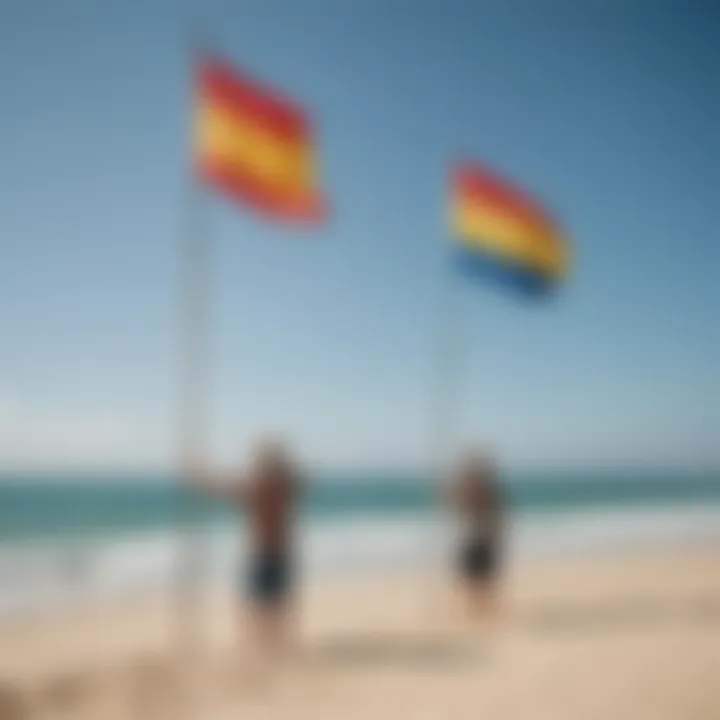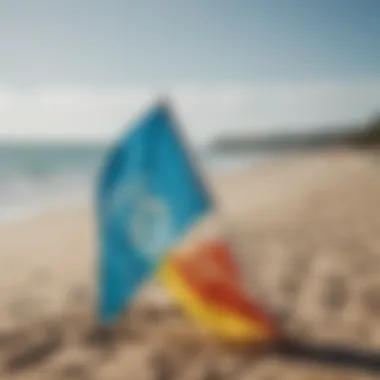Understanding Beach Flags: Safety and Communication


Intro
Beach flags serve as fundamental tools for safety and communication in aquatic environments. In today's fast-paced world, understanding their meanings and implications becomes increasingly crucial for both casual beachgoers and seasoned watersport enthusiasts alike. While some might see them as mere decorations fluttering on the sand, these vibrant flags tell important stories about the conditions of the water, safety guidelines, and unforeseen hazards.
Over time, the design and significance of beach flags have evolved. They now encompass a variety of colors and symbols, each conveying specific messages. As we delve deeper into understanding beach flags, it's vital to recognize how knowledge of these signals can enhance safety and elevate the overall beach experience. By fostering awareness within beach communities, we can cultivate a culture of prevention that reduces risks associated with water activities.
Let's explore the techniques and skills involved in interpreting and using beach flags today.
Techniques and Skills
Essential Techniques for Beginners
For those just dipping their toes into the world of aquatic sports, grasping the basic meanings behind beach flags is a necessity. Here are some essential tips:
- Understanding Colors: Each flag color typically represents different safety conditions. For example, a yellow flag might indicate moderate surf and currents, while a red flag might signal dangerous conditions.
- Observation Skills: Devote a few moments to observing the beach upon arrival. Pay attention to flags, local signage, and lifeguard instructions. Getting familiar with these visuals can save lives.
- Communicating with Lifeguards: Don’t shy away from asking lifeguards for clarification. They are your firsthand resource when it comes to understanding safety protocols on the beach.
Advanced Skills for Experienced Watersport Enthusiasts
For those seasoned in the realm of water sports, being adept at interpreting flags and related signals enhances one’s proficiency:
- Anticipating Weather Changes: Experienced beachgoers should cultivate a knack for weather patterns, predicting how conditions may influence flag statuses. A sudden shift in wind can drastically alter water safety.
- Incorporating Navigational Systems: Use modern tools and apps that integrate weather forecasts and surf reports. This often provides context for the flag warnings displayed on the beach.
- Peer Knowledge Exchange: Engage with fellow enthusiasts to discuss insights and experiences. This communal sharing often sheds light on lesser-known nuances of beach flag systems.
"An educated beachgoer is a safer beachgoer. Knowing the flags can make the difference between a fun day and a dangerous situation."
Understanding beach flags equips individuals not only with raw knowledge but also a survival toolkit. It's a merging of traditional wisdom with modern awareness that can significantly elevate safety and enjoyment during water-related activities. As we continue examining this topic, we will dive into the role and design of beach flags.
Prolusion to Beach Flags
When venturing to the coast, there's a silent guardian waving high above the sands: the beach flag. These simple fabric indicators play a significant role in ensuring safety at aquatic venues. Understanding beach flags goes beyond just identifying their colors; it encompasses a larger narrative that connects safety, awareness, and community engagement. Each flag serves as a symbol, conveying critical information about water conditions to beachgoers. Knowing how to interpret these signals can mean the difference between a fun day in the sun and a dangerous situation into the deep blue.
Historical Context
Beach flags have a history that stretches back decades, even centuries in some coastal communities. As maritime activities grew, so did the need for effective communication regarding the safety of swimmers and surfers. Initially, it started with fishermen and lifeguards using makeshift markers to indicate safe conditions. Over time, this evolved into a standardized system, allowing beach authorities to promptly inform the public of any risks. To grasp their importance today, one must appreciate their roots. These flags are not merely pieces of cloth but rather, the echoes of traditions that emphasize the essence of safety in the great outdoors.
Purpose of Beach Flags
The primary function of beach flags is to provide immediate visual cues regarding swimming conditions. For instance, a red flag typically signals dangerous waters, suggesting strong currents or high surf, while a yellow flag indicates moderate hazards. Understanding these cues is essential not only for safety but also for fostering a culture of awareness among beachgoers.
In addition to their direct relevance to swimmer safety, beach flags also serve a broader purpose:
- Promoting Safety Practices: By clearly signaling the state of water conditions, flags encourage responsible behavior.
- Educating the Public: Lifeguards can conduct educational sessions, focusing on what each flag means, creating a bond between the community and its safety personnel.
- Reducing Emergencies: When beachgoers are aware of potential dangers, the likelihood of accidents decreases, creating a safe environment for all.
In essence, understanding beach flags is not just about deciphering colors but embodying an ethos of responsibility and mindfulness when interacting with nature.
Current State of Beach Flag Systems
The current state of beach flag systems represents a critical aspect of water safety, reflecting how beachgoers interact with their environment. As beaches have become a popular gathering place, the clear communication of water conditions through flags has evolved in significance. Implementing beach flags effectively can mean the difference between a day of enjoyment and a day of disaster. It's an ongoing challenge to ensure that the public understands what these flags signify, making education and awareness paramount.
Varieties of Flags
Red Flags
Red flags serve as a universal warning sign that conditions are dangerous for swimming. They signal extreme surf conditions, strong currents, or even the presence of marine creatures such as jellyfish. Their powerful visibility in the beach setting ensures that any swimmer or surfer can easily spot them.


A red flag's key characteristic is its clear message: "Do not enter the water." For those who are not familiar with the area, the red flag acts as a lifebuoy to prevent potential accidents. The significant advantage is that it helps maintain safety by discouraging risky behavior, especially among inexperienced swimmers. However, the downside can sometimes be troublesome; it may restrict activity on otherwise safe days if the flag is raised unnecessarily due to misinterpreted conditions.
Yellow Flags
Yellow flags indicate that the conditions are potentially rough but manageable for experienced swimmers. An important aspect of yellow flags is that they advise caution, suggesting that swimmers should stay vigilant and aware of changing conditions. This flag acts as a middle ground in warning, neither completely prohibitive nor entirely assuring.
A notable characteristic of yellow flags is their direct appeal to experienced beachgoers. They are a beneficial choice for those familiar with ocean dangers, making it clear that swimming is allowed with caution. The unique feature of yellow flags lies in their nuance; they embrace a dual message of hazard awareness while still permitting water activity. One disadvantage is that inexperienced swimmers may misinterpret the flag as a full green light, leading to potentially risky situations.
Green Flags
Green flags usually signify clear and favorable swimming conditions, a welcome sight for beach enthusiasts. They indicate that it is safe to swim, but it's essential to note that even on green flag days, swimmers should remain responsible and attentive to any sudden changes in conditions.
The key aspect of green flags is their reassuring presence. They make the beach atmosphere more inviting, suggesting a safe environment. The unique advantage here is that they can enhance beachgoers' enjoyment, encouraging swims, sunbathing, and water sports that contribute to a fun-filled day. Nevertheless, the downside might be an occasional complacency from swimmers who may overlook precautionary measures simply because the flag is green.
Purple Flags
Purple flags mark an important aspect of beach safety concerning marine life and environmental hazards, such as jellyfish or rip currents. Their distinct shade serves as a warning that extra caution is needed, particularly for those who may not be fully aware of local wildlife activity.
This flag's key characteristic is its emphasis on marine safety. While it isn't as commonly seen as red or yellow flags, purple flags have become increasingly relevant as beaches experience more encounters with jellyfish and other potentially dangerous creatures. Due to this, they have garnered popularity among divers and swimmers alike who recognize the need to stay alert. One challenge regarding purple flags lies in their interpretation; not all beachgoers are aware of what they represent, leading to possible underestimations of risk.
Standardization Across Regions
Inconsistent flag systems across different beaches can present confusion and risks when beachgoers travel from one region to another. As flag classifications vary, the pressing need for standardization cannot be ignored. Ideally, all coastal areas should adopt a common flag system that serves the same purpose and meaning, fostering greater awareness and safety on a larger scale. On a broader level, the development and implementation of a standardized beach flag system can not only enhance public safety but also ensure uniformity in emergency responses to water safety incidents, effectively bridging the gap between local practices and visitor expectations. The goal is not just about flags but ensuring that every beachgoer understands their significance in real-time situations.
Importance of Beach Flag Education
Understanding beach flag education is crucial in ensuring safety at aquatic venues. The flags serve as visual signals that communicate current water conditions to beachgoers. When properly understood, these flags can significantly reduce the likelihood of accidents and enhance the overall experience at the beach. Educating the public about the meaning and purpose of these flags fosters a culture of awareness and responsibility, which is especially vital considering the unpredictable nature of the ocean.
Educating the Public
Education about beach flags cannot be overstated. It is imperative to have a clear and consistent message to beach visitors on what each flag signifies. People often visit coastal areas with little or no knowledge of water safety signals, which can lead to misunderstandings. For instance, a yellow flag may indicate caution, but an unaware swimmer might misinterpret it as safe conditions and put themselves in danger.
To effectively convey this information, educational campaigns using various methods can be adopted:
- Visual Displays: Signs near entrances or at lifeguard stations can provide quick access to flag meanings.
- Social Media Outreach: Engaging posts on platforms like Facebook and Reddit can spread awareness amongst local communities, especially during peak seasons.
- Workshops: Local community centers or schools can host workshops to teach beach safety, incorporating real-life scenarios and flag interpretations.
Encouraging participation from beachgoers in these educational efforts helps cultivate a shared responsibility toward safety. When individuals understand the signals, they are more likely to advocate for safer practices among their peers.
Involvement of Lifeguards
Lifeguards are central to the communication of beach flag safety. They not only maintain the flags but also play a key role in educating visitors. Their presence should instill confidence among swimmers, as lifeguards can provide on-the-spot information regarding water conditions and safety protocols.
Their involvement may include:
- On-the-Spot Training: Lifeguards can hold briefings or chats with beachgoers about current conditions.
- Consistent Updates: By regularly updating flags based on changing conditions, lifeguards can effectively communicate with beach visitors. This adaptability is key in ensuring safety.
- Personal Interaction: A simple conversation about flag meanings can lead to increased understanding and caution among the public.
Overall, lifeguards are not just protectors but educators. Their daily interactions with beach attendees help establish a culture of safety that promotes both enjoyment and mindfulness.
As community support and involvement grow, so does the potential for effective beach flag education, paving the way for safer beach experiences.
Challenges in Beach Flag Communication
Beach safety is a cornerstone of enjoyable aquatic experiences, yet the communication of safety through beach flags often comes with hurdles that can compromise that very safety. Understanding the challenges tied to beach flag communication is imperative. These challenges can affect not just individuals, but entire communities that rely on the clear signaling that flags provide. It's in these nuanced concerns that we can find opportunities to enhance safety protocols and educate beachgoers more effectively.


Misunderstanding Flags
One of the biggest issues that arises with beach flags is the widespread misunderstanding of their meanings. What might be second nature to seasoned surfers and lifeguards can often elude the average beachgoer. For instance, while a red flag typically indicates dangerous conditions, many casual beach visitors may not fully grasp the implications or severity of that warning.
- Cultural differences can compound this misunderstanding. Beaches that see visitors from various regions or countries may witness a spectrum of interpretations regarding flag colors. Not every visitor will be aware of standard flag meanings based on localized practices.
- Anecdotal evidence suggests that many individuals believe that the flags are more about ambiance than they are indicators of safety. In light of this, educational efforts need to be doubled down on. Solid public information campaigns that clarify flag meanings during moments of high influx at beaches could make a significant difference.
Varying Local Practices
Adding another layer of complexity, local practices regarding beach flag systems vary significantly from one place to another. Some locations may employ flag systems that reflect their unique environmental challenges or risks but lack a standardized approach that makes sense across regions. For instance, in one coastal town, a yellow flag might indicate conditions suitable for swimming, while in another, it could suggest caution without an outright ban on swimming.
- Variability in regional practices not only leads to confusion but also skepticism in safety provisions. It’s not unheard of for beachgoers to disregard flags altogether due to inconsistent messaging. When the rules differ, one can’t blame the public for feeling unsure of how to navigate the waters—or the sands—safely.
"Safety communication should be as reliable as the tides; only then can we ensure everyone enjoys the beach to its fullest."
- Adopting a unified flag system across regions could alleviate some of these discrepancies, creating a common language for flag signals.
A collaborative effort involving lifeguards, local governments, and community organizations may well be the way forward. This proposed partnership is critical for aligning education efforts and ensuring that residents and visitors alike receive the necessary information. Considerations must be made to develop materials that convey flag meanings effectively, possibly incorporating visuals or illustrations to bypass language barriers.
In summary, the road to understanding beach flags is far from smooth due to misunderstandings and local variances. Nonetheless, with awareness and commitment, this communication can be sharpened and streamlined, serving not just as a guide through surf but as a beacon of safety.
Collaboration for Improvement
In the sphere of beach safety, particularly concerning beach flags, collaboration stands as a backbone to effective communication and awareness. The intertwined roles of various entities play a crucial part in promoting understanding and adherence to flag signals. This collaboration is more than just a nice-to-have; it’s a fundamental necessity that can significantly enhance the safety protocols on our beaches.
Partnerships with Local Governments
The various levels of local government are pivotal in shaping and enforcing regulations that govern beach safety. When local governments forge partnerships with lifeguard services, beach management teams, and even educational institutions, they create a more cohesive framework for flag communication.
For instance, a beach town may work alongside the local municipality to fund better training for lifeguards on how to convey flag meanings effectively to the public. This collaboration can extend to having informational signage that educates beachgoers. When a region's lifeguards are well-versed and equipped to explain the implications of different flags, it raises public awareness.
Benefits of partnerships like this include:
- Increased Resources: Government funding can improve access to training materials.
- Standardization: Local governments can ensure that laws surrounding beach safety are uniformly applied across different beaches, reducing confusion.
- Public Engagement: Collaborative efforts may host community events that inform the public about safety measures, turning knowledge into routine behavior.
"Without solid partnerships, the time and effort spent on beach safety can often be in vain."
Engagement of Community Organizations
Community organizations, often grassroots in nature, play an invaluable role in amplifying the educational efforts surrounding beach flags. These groups can be instrumental in implementing grassroots campaigns that teach locals and tourists alike about flag signals. Suppose a local surf club collaborates with a nearby environmental organization. In that case, they could host beach cleanup days while simultaneously providing educational sessions about recognizing and understanding beach flags.
The nature of these collaborations can vary but might include:
- Workshops: Organizing interactive sessions where community members learn about the importance of beach flags in real-life scenarios.
- Social Media Campaigns: Using platforms like Facebook and Reddit to reach a broader audience, sharing tips and information that emphasize awareness and safety.
- Collaborative Events: Engaging in community events can serve dual purposes of fun and education. For example, a beach fair could involve booths that explain flag meanings, equipped with demonstrations from lifeguards.
Through these synergies, community organizations and local governments can create an environment that prioritizes beach safety.
In summary, the collaboration between local governments and community organizations not only creates a better understanding of beach flags but also evokes a sense of collective responsibility for safety on our shores. As we refine these partnerships, the implications for public awareness and adherence to safety measures can change the safety landscape along coastlines everywhere.
Case Studies: Effective Flag Implementation
Examining case studies that focus on effective flag implementation reveals the direct impact of beach flag systems on public safety and awareness. Insights drawn from these cases not only underline the necessity of a structured approach but also showcase the successful methods implemented in various locations. Through these narratives, stakeholders can grasp what works and adapt successful strategies to their own beaches.
Successful Programs


Various regions have adopted innovative flag systems tailored to the unique challenges they face. For instance, California has a comprehensive flag system that integrates local education campaigns with real-time weather updates. Their model focuses on community engagement with educational workshops that educate residents and visitors on beach safety and flag meanings.
Similarly, in Australia, programs like the Surf Life Saving movement employ a color-coded flag system along with lifeguard demonstrations. This method allows beachgoers to witness and understand flag meanings firsthand. Lifeguards play an active role, engaging with the public to explain the relevance of each flag, enhancing trust and clarity.
One notable example comes from Florida, where lifeguards developed visuals and infographics that illustrate the flag colors and associated water conditions. This approach has not only raised awareness but also significantly reduced the number of incidents, creating a safer environment for all.
Analyzing Impact
Assessing the impact of these case studies highlights several key benefits:
- Increased Awareness: Clear flag systems have proven to raise public consciousness about beach safety.
- Reduced Incident Rates: Engaging educational initiatives have been linked to fewer water-related accidents.
- Community Trust: Lifeguard involvement fosters a relationship between the community and safety officials, making people more receptive to advice and information.
"The integration of educational programs with flag systems significantly elevates beach safety, showing that knowledge is indeed power in preventing accidents."
In reviewing these implementations, it's essential to consider the adaptability of these programs. Each region offers distinct challenges that may not translate directly; thus, customization is critical. Understanding demographics, climate, and local culture shapes how effectively flags communicate their messages.
Future Trends in Beach Safety
As we look toward the horizon of beach safety, it is vital to understand how emerging trends can reshape the dynamics of community engagement, education, and proactive measures for protection against aquatic hazards. While beach flags have long served as essential tools in signaling conditions to swimmers, their integration with modern advancements promises to elevate the overall safety experience. The potential benefits of embracing these trends are multifold, catering not only to the instincts of safety fans but also to the needs of diverse beachgoers who crave clarity when enjoying our coastal playground.
Technological Advancements
The advent of technology stands as a San Francisco treat – it brings a certain value when crafting superior safety measures on the sandy shores. In recent years, we’ve observed the evolution of flagging systems that merge traditional physical flags with digital innovations. For instance, smartphone applications are emerging as powerful tools, alerting beach patrons about the current flag status through user-friendly notifications. Imagine walking onto the beach and receiving real-time updates about water conditions right on your phone; that’s convenience at its finest.
In addition to apps, some beach systems are experimenting with smart flags embedded with sensors that relay immediate data regarding wave heights, water temperature, and potential rip current activities helping lifeguards gauge risks more accurately. These smart flags can change colors based on readings, offering a nuanced understanding of conditions as they evolve throughout the day.
Moreover, drone technology is being utilized to monitor beach activities. Drones equipped with cameras and software can assess crowds, identify dangerous situations, and even pinpoint swimmers in distress. This aerial advantage allows for rapid lifeguard response, significantly enhancing swimmer safety. Revising the way we view safety with such technology fundamentally changes the narrative surrounding beach ecosystems; it shifts from reactive measures to proactive foresight.
Changing Regulations
As societies evolve, so do the regulations that guide them. Changes in beach safety regulations are intertwined with the overarching theme of enhancing public awareness and engagement. Various local governments are beginning to standardize procedures, ensuring that users across different regions can decipher beach flags consistently. This alignment is crucial, especially for travelers who might feel lost in a sea of different signals.
Regulatory bodies are also paying closer attention to the incorporation of public input in establishing safety measures. Engaging local communities by sourcing feedback on potential flag integrations or safety announcements can lead to more tailored solutions that resonate with beachgoers. Imagine a beach where safety pamphlets are distributed or safety seminars take place—offering firsthand experience and demonstration of the flag systems in a relatable manner.
Furthermore, reevaluation of communication strategies surrounding flag protocols adds depth to regulations. It’s no longer sufficient to merely hang flags; lifeguards and rescuers are encouraged to create educational dialogues that provide clear explanations. Using social media platforms to broadcast flag meanings, weather alerts, and safety reminders addresses a wide audience effectively and justly.
"Changing regulations ensures that the beach environments evolve, allowing safety measures to stay at the forefront of access and knowledge."
As you can see, the future of beach safety seems bright, peppered with both technological enhancements and legislative revamps. The road ahead harbors fresh possibilities for engaging educational aspects with an increasing focus on community involvement. But like any journey, ensuring that these advancements resonate effectively among beachgoers will be vital for cultivating a culture of abiding safety.
Ultimately, as these evolving trends take shape, they endeavor to enhance both awareness and the experiences of everyone who frequents our beloved beaches.
Closure
In reflecting upon the subject of beach flags, it becomes clear that these colorful signals are not mere decorations dotting our coastlines. Instead, they serve as critical components of water safety and communication, influencing the choices that beachgoers make every day. Understanding their meanings and implications can significantly impact outcomes in potentially risky situations, making awareness about these flags crucial.
Summary of Key Points
- Beach flags are more than just visual markers; they convey vital information about water conditions, safety risks, and regulations.
- Historically rooted in lifeguard systems, these flags have evolved, gaining importance in different regions and cultures.
- Clear comprehension of flag positions prevents misunderstandings, which can lead to dangerous scenarios.
- Recent studies highlight that consistent communities engagement and education can drastically raise flag awareness, refining the collective response to aquatic dangers.
To sum it up, the role of beach flags transcends their simple visual appeal; they stand as shielding beacons for beachgoers, a reminder of the ocean's unpredictability.
Call to Action for Awareness
As we step closer to our beloved beaches, it is vital that we share knowledge about beach flags among friends, family, and fellow visitors. Initiatives such as community workshops, educational pamphlets, and social media campaigns can be effective in creating an informed public.
- Consider visiting local community boards – they often have information on beach safety events.
- Spread awareness on platforms like Facebook, sharing posts that explain the meanings behind the colors and positioning of flags.
- Encourage beach patrols and lifeguards to engage with visitors, creating a culture of safety and awareness around the flags and their meanings.
Through concerted efforts, we can transform beach safety from a vague notion into a culture of respect and vigilance around ocean currents and conditions. Let’s be proactive and take action to understand beach flags today, ensuring safe shores for everyone.







